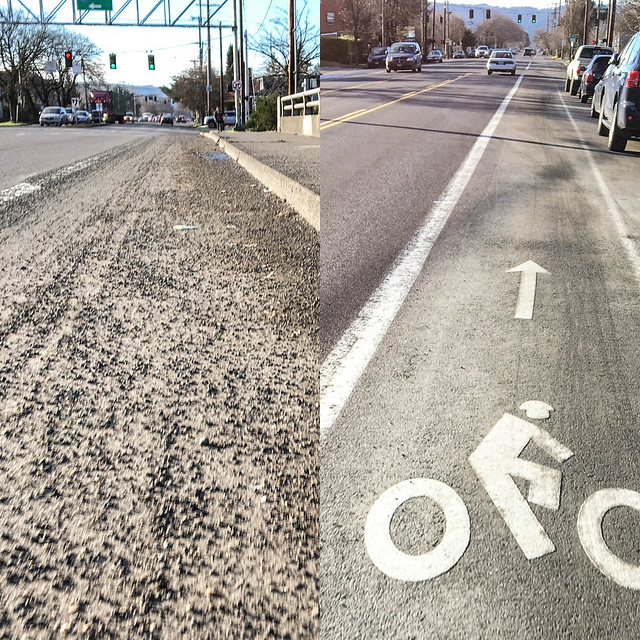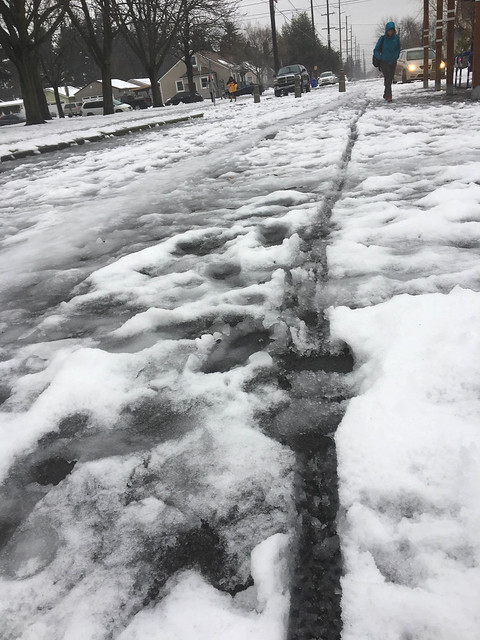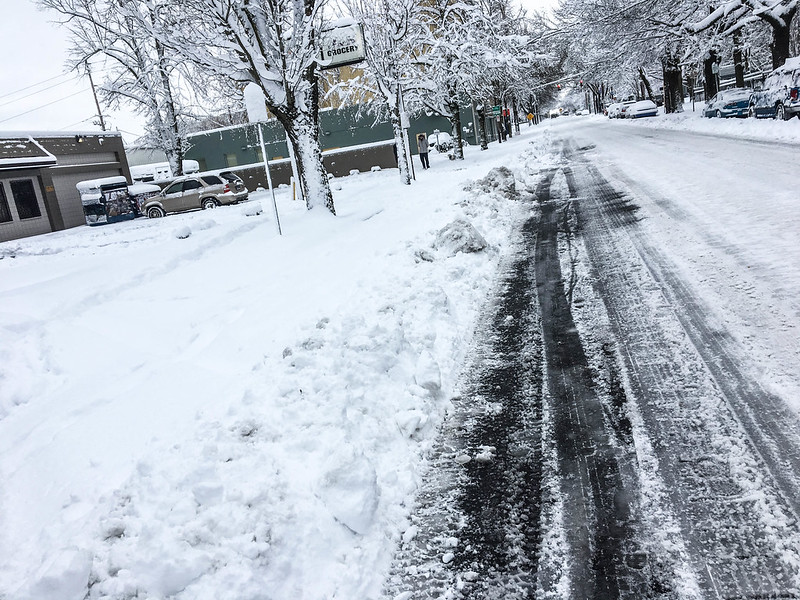
(Photos: J. Maus/BikePortland)
For people who ride bikes in Portland, those nasty winter storms are far from over. The weeks of rain, ice, snow, studded tires, chains, and plows have wreaked havoc on roads — especially in the space used for cycling.
It’s one thing to deal with it in a well-cushioned car, but another thing entirely when trying to navigate a bicycle: Ride in the gravel, mud and other hazards and you risk flats or losing control; ride in the lane and you risk interactions with motor vehicle users.
We hate to complain; but this situation is not new. It’s also dangerous and we haven’t seen significant steps taken to improve it even though it has been on the City’s radar for many years. We’ve documented hazardous post-storm cycling conditions (and PBOT’s response to it or lack thereof) in 2007, 2008, 2009 and 2014.
During the snow, the City doesn’t plow bicycle routes. Then when the snow finally melts, people who ride bikes are left with spaces full of gravel and other hazards. This is unsafe and unfair — especially in a city with a committment to Vision Zero and a goal of 25 percent bicycle ridership by 2030.


And it’s not as if people stop riding in nasty weather. After our last record-breaking snowstorm in 2008, then-mayor Sam Adams conducted a bike-specific winter storm survey that found 70 percent of (450) respondents who bike actually attempted to ride in the snow. We reported that the city was, “in crisis mode for several weeks” dealing with cleanup and other storm-related issues. Even so, it doesn’t appear they’ve made substantive changes to how they respond.
Our social media timelines have been full of reports of gravel in bike lanes citywide. I’ve seen it myself from St. Johns to deep outer southeast and everywhere in between.
Dave Guettler, the owner of River City Bicycles and River City Bicycle Outlet on the central eastside (two shops that have a combined staff of 70 and account for more than 5,000 bicycle sales a year), has become so concerned about the issue he fired off a letter to Portland Mayor Ted Wheeler and PBOT Commissioner Dan Saltzman yesterday. Here’s an excerpt:
“This winter, perhaps more than any other in recent memory, we have heard the concerns expressed by customers and staff alike about the safety of Portland’s roads due to snow and ice.
We have heard about and experienced the absence of safe, designated routes during snow storms, the prolonged timeline in making these designated routes accessible after the snow has receded, and the distinct lack of follow through with routes and access in certain neighborhoods. Our customers come to us with these concerns because we are are seen as stewards of cycling advocacy for this city, a city that trades on a shining bicycle-friendly reputation. What we hear resoundingly, though, is that they don’t feel safe.
… River City Bicycles asks on behalf of all road users that the City of Portland act quickly to clean the streets of hazardous debris.
For the sake of all Portland bicyclists, the significant business of bicycles in Portland, and the city’s Platinum reputation, we demand action toward safer roads in winter months. This will include the swift removal of the hazardous debris that remains after winter storms and a consistent message to all transportation users that bicycles have every right to to the road no matter the weather.”
Advertisement

After the big storm of 2008, it took the City of Portland about 6-8 weeks to clean up about 1,000 cubic yards of gravel (that’s about 1,000 truckloads). And they don’t typically get it all. City crews shoot for a 75 percent pick-up rate, but after that ’08 storm a spokesperson told us they were only able to pick up 60 percent of the gravel because of high winds and rain.
We need a substantive change in policy and practice from the City of Portland. Thankfully it appears they might be on the verge of doing just that.
To get the latest, we asked PBOT Director Leah Treat a few questions about the storms’ impact on bicycling (note that she refers to gravel as “sand”) and their plans to address it. Based on her answers it appears we finally might make some progress on this issue:
As an everyday bicycle rider yourself, how do you feel the City did in terms of managing bikeways during and after the storm?
No doubt about it, this was a challenging storm. Across the city, the packed snow and ice lingered on the roadways and the bikeways. This certainly made it hard for people riding bikes to get around. Once the storm passed, we were able to get the streets into a basic navigable condition so that our transit system could operate. This gave people, include people who would normally bike but who wanted an alternative to their usual mode of transportation, a viable option for getting around Portland.
The City’s current Snow & Ice Plan and the City’s plow routes map does not take cycling into account. Given that Commissioner Saltzman sounds like he’d like to do some sort of review/report of that plan, will you advocate for a specific City policy that addresses cycling routes (such as adding them to the plow route map, mandating post-storm sweeping of gravel and debris, and so on)?
Yes. We are specifically going to look at expanding our de-icing and plow routes to include neighborhood greenways. In terms of post-storm sweeping, it is already part of our standard operating procedure to sweep up the gravel from the streets and bikeways. See below for more detail about what we’re currently doing in this regard.
Did PBOT learn anything about preserving and maintaining key bikeways during/after these storms?
Yes, as I mentioned above, one of the key things we learned is that we need to seriously look at expanding our de-ice and plow routes to include neighborhood greenways. These are important travel routes, and we need to have a clear estimate of what it would cost in labor and equipment to de-ice and plow them.
Now that the snow has melted, bike lane striping looks pretty bad. Chains, gravel, ice, snow, and plow trucks have taken a toll. Is PBOT going to do anything to work with BOM on some sort of hastened restriping timeline to address this issue?
Yes, this is on our radar as well, and we have already started to address the degraded striping. The best striping weather is when it is dry and temperatures are above 50 degrees. Since it looks like we will have a string of dry days we will be out striping even though it’s a bit on the cold side.
Now that roads are clear of snow and ice… Do you plan to do anything to speed up the removal of all the gravel that is currently fouling up many bike lanes throughout the city?
Yes, in fact, this past weekend we focused our sweeping on getting gravel out of the bike lanes because we know from experience that this is a concern that people have. For the next few weeks we will be prioritizing gravel removal. We will have two crews working on both the day and night shifts for the next two weeks. Also, we will have a crew on Saturday and Sunday focusing on gravel pick up. The goal is to get the gravel up before it migrates over to the curb lane. Once it is in the curb lane, the work gets more complicated because of the parked cars. In terms of how long it can take to pick up gravel, here is the rule of thumb we use: for every day that we put sand/gravel down, it takes 3-5 days to pick the same amount up. It takes longer because the sweepers only travel up to 5 mph. Also, we have fewer sweepers than we do sand spreaders. With the length of this most recent storm, we estimate that it will take approximately three weeks to sweep up the gravel.
So there you have it. It could be mid-February before all the gravel is swept up. That’s about two months after the first storm hit. And note that Treat says PBOT is only “going to look at” de-icing and plowing neighborhood greenways. We must keep the pressure on.
Given that many major bike routes are the responsibility of the State of Oregon and Multnomah County, we hope they’ll complete their clean-up soon as well.
In the meantime, please keep documenting conditions so we can keep the pressure on these agencies. If there’s a particularly bad spot that you feel is urgent, please call the city street maintenance hotline at (503) 823-1700.
Stay tuned.
UPDATE: We’re getting lots of reports of sweeping! That’s great to hear. Please keep the reports coming.
— Jonathan Maus: (503) 706-8804, @jonathan_maus on Twitter and jonathan@bikeportland.org
BikePortland is supported by the community (that means you!). Please become a subscriber or make a donation today.


